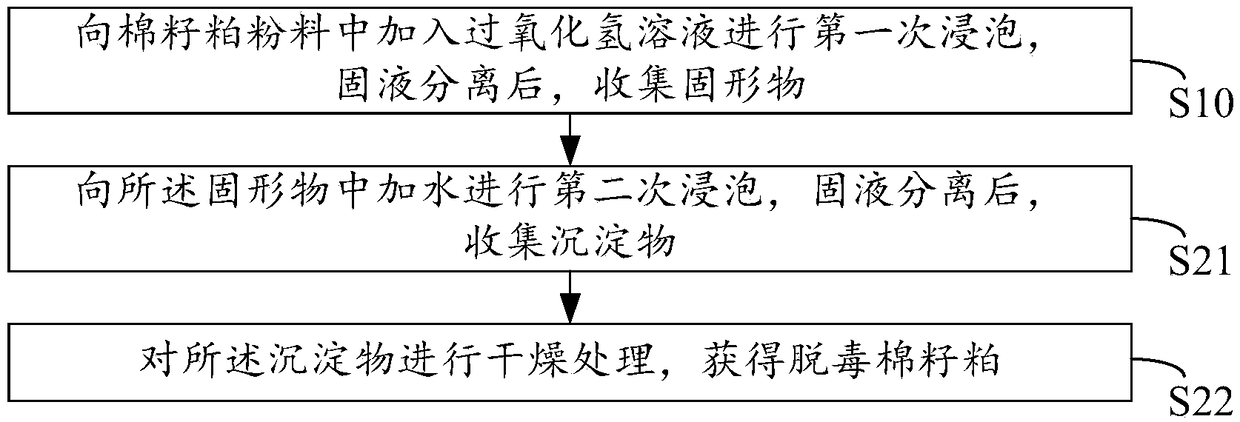Chemical treatment method for cottonseed protein detoxification processing
A technology for chemical treatment and cottonseed protein, applied in the field of cottonseed meal processing, can solve the problems of low dephenolization rate, solvent recovery and residue, high energy consumption, harsh fermentation conditions, etc. The effect of high protein recovery
- Summary
- Abstract
- Description
- Claims
- Application Information
AI Technical Summary
Problems solved by technology
Method used
Image
Examples
Embodiment 1
[0044] (1) Take 5g of dry cottonseed meal that has been mechanically crushed and passed through a 30-mesh sieve, add 25mL of hydrogen peroxide solution with a concentration of 3% and pH 4.0, mix well, soak in a 70℃ water bath for 1.5h, and then pass it through a centrifuge at 4000rpm Centrifuge at speed for 5 minutes, discard the supernatant, and collect the solids;
[0045] (2) Add tap water with a solid-to-liquid mass ratio of 1:10 to the solids, soak for 4 minutes at 22°C (continuous stirring during the soaking process), then centrifuge at 4000 rpm for 5 minutes through a centrifuge, and discard Supernatant, and then repeat the above-mentioned tap water soaking and centrifugal treatment process once, the supernatant obtained by centrifugation will not change color by the acid starch potassium iodide solution, discard the supernatant and collect the precipitate;
[0046] (3) Dry the precipitate in a ventilated drying box at a temperature of 50°C until the water content of the mat...
Embodiment 2
[0048] (1) Take 5g of dry cottonseed meal that has been mechanically crushed and passed through a 50-mesh sieve, add 10 mL of hydrogen peroxide solution with a concentration of 1.5% and pH 6.0, mix well, soak in a water bath at 80°C for 3 hours, and then pass it through a centrifuge at 4000 rpm. Centrifuge at speed for 10 minutes, discard the supernatant, and collect the solids;
[0049] (2) Add tap water with a solid-liquid mass ratio of 1:20 to the solids, soak for 3 minutes at 25°C (continuous stirring during the soaking process), and then centrifuge at 4000 rpm for 10 minutes through a centrifuge, and discard Supernatant, and then repeat the above-mentioned tap water soaking and centrifugal treatment process once, the supernatant obtained by centrifugation is not colored by the acid starch potassium iodide solution, discard the supernatant and collect the precipitate;
[0050] (3) Dry the precipitate in a ventilated drying box at a temperature of 80°C until the water content of...
Embodiment 3
[0052] (1) Take 20g of dry cottonseed meal that has been mechanically crushed and passed through a 50-mesh sieve, add 80 mL of 2.5% hydrogen peroxide solution with a pH of 8.0, mix well, soak in a water bath at 50°C for 8 hours, and then pass it through a centrifuge at 3000 rpm Leave for 15 minutes, discard the supernatant, and collect the solids;
[0053] (2) Add tap water with a solid-to-liquid mass ratio of 1:12 to the solids, soak for 2 minutes at 27°C (continuously stirring during the soaking process), then centrifuge at 3000 rpm for 15 minutes through a centrifuge, and discard Supernatant, and then repeat the above tap water soaking and centrifugation process 3 times, the supernatant obtained by centrifugation is not discolored by the acid starch potassium iodide solution, discard the supernatant and collect the precipitate;
[0054] (3) Dry the precipitate under the sun irradiation at a temperature of 30°C until the water content of the material is not higher than 15%, and 1...
PUM
 Login to View More
Login to View More Abstract
Description
Claims
Application Information
 Login to View More
Login to View More - R&D
- Intellectual Property
- Life Sciences
- Materials
- Tech Scout
- Unparalleled Data Quality
- Higher Quality Content
- 60% Fewer Hallucinations
Browse by: Latest US Patents, China's latest patents, Technical Efficacy Thesaurus, Application Domain, Technology Topic, Popular Technical Reports.
© 2025 PatSnap. All rights reserved.Legal|Privacy policy|Modern Slavery Act Transparency Statement|Sitemap|About US| Contact US: help@patsnap.com



